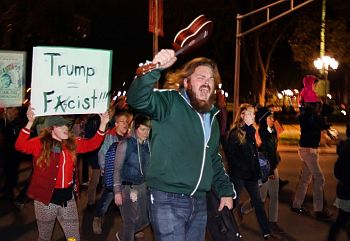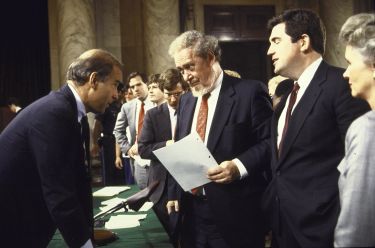Faking it and Making it
From The New CriterionThe post-election period has been rich in ironies, mostly at the expense of the media who remain blind to them through their inveterate self-righteousness. First and most spectacularly, perhaps, there was the outcry against Donald Trump’s asseveration, before November 8th, that the election was “rigged” against him. The suggestion that Mrs Clinton’s approaching victory — which at the time appeared to be a sure thing — would be illegitimate was universally denounced in the media as a crime against democracy. Then, after the shock result, they turned on a dime and started claiming that Mr Trump’s victory had itself been illegitimate, for any number of reasons — either on account “voter suppression” or of his supposed “$2 billion worth of free media” or the announcement by James Comey in the election’s final ten days of an FBI investigation into the Clinton Foundation or, if nothing else, because (as has been true throughout America’s constitutional history) the popular vote, won by Mrs Clinton, was not the determinative factor in deciding who had actually won. In some quarters, Mr Trump’s election was taken as evidence that democracy itself was much over-rated.
Then there was the irony of the violent reaction to defeat by mostly young supporters of Mrs Clinton in cities across the country — many of them apparently under a similar misapprehension to that of a screaming 17-year-old girl in San Francisco seen holding up a sign in a Washington Post photo reading “Nazi President.” Another youth from the same collection of images, this one in New Haven, holds a sign reading “Trump=Fascist” — except that “Fascist” appears to have been misspelled as “Facist” and has an s squeezed in between the a and the c in a different color. The poor dears! Obviously, no one has ever explained to them that the fascists were the people who took to the streets to engage in vandalism and violence while denouncing and threatening and intimidating those who disagreed with them, not the people they were denouncing and threatening and intimidating — and, in at least some cases, beating up. In other words, if there were any fascism going forward, it was all theirs.
 |
The irony, I suppose, was necessarily lost on those who were also denouncing, their faces contorted with hatred, the “hate” they attributed to Mr Trump. The media gave a respectful and even a sympathetic hearing to the views of the protestors instead of denouncing them as they had done the pro-Trump rioters expected in the wake of a Clinton victory. “For many of the people who have turned out for the current protests, it has been a kind of group therapy,” reported The New York Times, “and [they] already seem to be cementing new, cross-sectional liberal coalitions.”
Meanwhile, the editorialists and columnists preferred to concentrate on various isolated and anonymous manifestations of reported or graffitied racial slurs or anti-immigrant sentiments, as if these must be the responsibility of the winning candidate. “Denounce the Hate, Mr. Trump,” demanded the editorial board of The New York Times, who obviously weren’t thinking of their own hate any more than the children who were carrying “Love Trumps Hate” signs. No, no. It was always axiomatic that Mr Trump was the hater. “Hateful acts are on the rise,” echoed The Washington Post, “and it’s Trump’s responsibility to take a stand.” It clearly never occurred to anyone at the Post, either, that the hate-filled demonstrators could have committed any “hateful acts.”
Most ironic of all from the point of view of the media — or rather from the point of view that the media seem incapable of adopting, even though it would be infinitely to their benefit in terms of both truth and readability for them to do so — was the outcry against “fake news,” said to be fostered and encouraged by their upstart rivals in the social media, possibly with the assistance of Russian or Macedonian hackers (experts said) plying gullible Trump supporters with disinformation (or accurate but purloined information) tending to the disadvantage of Mrs Clinton. Worst of all, these dark, clandestine forces were causing a drop in readership and in newspaper advertising revenue and so endangering the livelihood of proper journalists, like the criers-out.
“The internet-borne forces that are eating away at print advertising are enabling a host of faux-journalistic players to pollute the democracy with dangerously fake news items,” thundered Jim Rutenberg of The New York Times on the day before the election. Mr Rutenberg, you may remember, was the man so confident of his own and his fellow journalists’ intimacy with the truth that last summer he called on his media colleagues to join the Democrats in denouncing Mr Trump’s “lies” (see “After the Fact in The New Criterion of October, 2016) — as if they were not already doing so.
His descent into advocacy journalism was to him no descent at all when political right and wrong, good and evil, were as clear-cut and indisputable as they were to him and to those of his journalistic colleagues whose careers he now saw as being endangered by the numbers of their former readers flocking to alternative news sources. And yet, somehow, he was able to make no connection between that dwindling readership and the media partisanship which he had only made explicit but which had already brought people’s trust in the media, as measured by pollsters, to historically low levels.
“Fake news,” he might have reflected, was in the eye of the beholder, and a lot of people saw the news that the un-faux, unsocial media have been promoting for the past year and a half (and much longer, if the truth be told) as being quite as fake as that of any troll on Facebook. Thus the pretense of the media “fact-checkers”that facts are readily identifiable among the welter of lies and half-truths is increasingly transparent to readers who already have good reason for supposing that the media’s interest in “truth” is far from disinterested. And, sure enough, fake news appeared always and everywhere to be a partisan phenomenon. None of the many stories and columns about it that I read included any examples from supporters of Mrs Clinton, which suggests that the whole idea — in the form of “post-truth,”which was named the Oxford Dictionaries’ international word of the year for 2016 — was no more than an attempt to claim some sort of scholarly or quasi-scientific authority for the insinuation of lying against Mr Trump that the media had been making in cruder and more direct forms for months.
Margaret Sullivan, the media columnist of The Washington Post, quoted Scottie Nell Hughes, a Trump supporter, as saying on “The Diane Rehm Show” that “there’s no such thing, unfortunately, anymore, of [sic] facts” and treats this as a self-evident falsehood — which, paradoxically, only confirms Ms Hughes’s point by noting that what is a fact to Ms Hughes is no fact to Ms Sullivan and vice versa. This, then, leads the latter into a version of the Trump apocalypticism that was so much a feature of the post-election period.
It’s time to dust off your old copy of 1984 by George Orwell and recall this passage: “The Ministry of Peace concerns itself with war, the Ministry of Truth with lies, the Ministry of Love with torture and the Ministry of Plenty with starvation. These contradictions are not accidental, nor do they result from ordinary hypocrisy: they are deliberate exercises in doublethink.”
In other words, Trumpism is the second coming of the Stalinism that Orwell was satirizing. And that, presumably, is a fact. To her.
What could be faker than that? And was it not also a form of “fake news” for the Washington Post to allow Terrence McCoy to report on the likes of a couple of obscure click-bait artists named Paris Wade and Ben Goldman, said to be making lots of money out of fabricating stories to appeal to Internet-browsing Trump supporters, as if they were representative of the necessarily unofficial pro-Trump media, amateur and professional, which has arisen as an alternative to the partisan media of the other side? If “fake news” is a problem, it must be a problem to both sides or else the fake news story is itself a species of fake news — particularly if by that is meant no more than dubious information promulgated solely for partisan advantage. Thus when Dana Milbank wrote of “Trump’s fake-news presidency” or Ruth Marcus of “The post-truth presidency” within days of the election and well before that presidency had even begun, anyone more charitably disposed to Mr Trump than The Washington Post could be excused for seeing fakery at work there as well.
A note of skepticism about the whole idea was sounded by John Herrman of The New York Times who saw “Fake News” as being, for the left, “the discovery of the error that explains everything.” He thinks this “misunderstands a new media world in which every story, and source, is at risk of being discredited, not by argument but by sheer force.”
“Fake news” as shorthand will almost surely be returned upon the media tenfold. The fake news narrative, as widely understood and deployed, has already begun to encompass not just falsified, fabricated stories, but a wider swath of traditional media on Facebook and elsewhere. Fox News? Fake news. Mr. Trump’s misleading claims about Ford keeping jobs in America? Fake news. The entirety of hyperpartisan Facebook? Fake news. This wide formulation of “fake news” will be applied back to the traditional news media, which does not yet understand how threatened its ability is to declare things true, even when they are.
“Threatened”? Surely, if the election showed anything it was that the traditional media’s ability to declare things true (or false) was, in fact, already long gone. Facebook, therefore, which Mr Herrman describes as “the company that created the system that resulted in hoax news stories,” is a symptom, not a cause. “Those,” he says, “who expect the operator of the dominant media ecosystem of our time, in response to getting caught promoting lies, to suddenly return authority to the companies it has superseded are in for a similar surprise.” But Facebook couldn’t “return authority” to the traditional media if it wanted to, since that authority was lost by the media’s naked partisanship in the last three elections — and by the very imperfectly clothed kind that preceded it.
As Brendan O’Neill of the British left-libertarian site Spiked Online wrote:
This is the great irony of the fake-news panic that has swept the Western media in recent days . . . It’s the fakest news story of the week. It might not be as utterly invented as the one about Hillary’s people abusing children in a pizza restaurant in Washington, DC. But it involves a profounder avoidance of truth, a deeper unwillingness to face up to facts. In particular the fact that the rise of fake news, ‘alternative news’ and conspiracy theories speaks not to the wicked interventions of myth-spreaders from without, but to the corrosion of reason within, right here in the West. It speaks to the declining moral and cultural authority of our own political and media class. It is the Western world’s own abandonment of objectivity, and loss of legitimacy in the eyes of its populace, that has nurtured something of a free-for-all on the facts and news front.
I myself would be wary about using the word “objectivity” to describe the journalistic ideal, since objectivity in any absolute sense is impossible. We have to see things from our own point of view. But democracy depends on the assumption that we can share a point of view as part of a people, of one country, no matter what our differences. Or, to put it another way, it’s the necessary assumption that those opposed to us politically are people of good will and basic honesty and decency who want the same things that we want — namely, the good of all Americans. That this assumption is also long gone was made clear with Hillary Clinton’s deploring of that “basket of deplorables” which she saw among the supporters of her opponent during the campaign. Though she subsequently apologized, does anyone doubt that this is how she really sees the world? The assumption mentioned above of good will on the part of those who oppose us which is necessary to democracy is no longer made by either side in our political wars — which are, indeed, more like war than politics in a democracy.
 |
What both the fake news, such as it is, and the outcry against it mask is a breakdown in the trust that our political culture — and any democratic polity — depends on. And what that comes from is the moralization of politics by the left with the assistance of the media. Their practice of identity politics is ultimately based on a Marxist-Leninist inspired division of the country into the exploited and the exploiters which allows for no common ground between them and depends on the assumption that what is good for one must be bad for the other. This tendency is exacerbated by the media’s obsession with scandal, which has contributed mightily to the moralization of politics and, therefore, to the anti-democratic assumption that political divisions are between good and evil — evil in contemporary terms being racist, sexist, xenophobic, Islamophobic, homophobic (even though Islam is itself homophobic) and, increasingly, capitalist.
In short, our politics is tending to the revolutionary — or counter-revolutionary if you prefer, since it comes to the same thing — and youthful idealists taking to the streets to shout about “fascism,” even if they have no idea what it means, seem to portend (at the risk of engaging in their own sort of hyperbole) a looming civil war just off the reality-TV stage. It may be only a post-modern sort of war, fought not for honor or territory but for TV-time, and with very limited casualties, but the uncompromising hostility on both sides leaves little rhetorical room for anything else. It also has in common with real war a need to portray the other side as evil in order to justify the effort to eliminate it. We might remember that “fake news,” under the name of propaganda, has always been a feature of war-time. The historian Robert G. Parkinson cited the example of our own revered Founder Ben Franklin, who fabricated atrocity stories against the British and their Indian allies during or just after the Revolutionary War. It might be a good idea for the non-revolutionary media — if there is such a thing anymore — to remember that the next time they are tempted to hype the opposition by trotting out their comparisons to Hitler or Stalin — or the devil who, as St John’s gospel reminds us, is the father of fake news.
Discover more from James Bowman
Subscribe to get the latest posts to your email.





